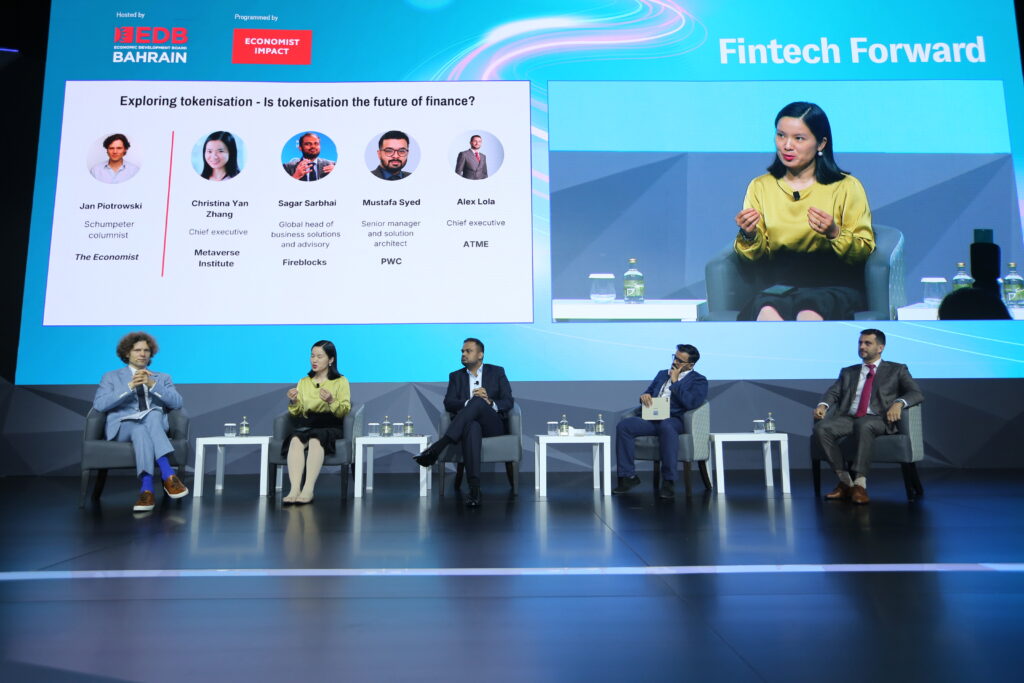Tokenisation is reshaping key financial sectors, enabling efficiency and accessibility.

The financial industry is seeing a fundamental shift with tokenisation, a blockchain-based approach to creating digital representations of real-world assets. As blockchain matures, banks, fintechs and regulators are increasingly looking to leverage this technology to build cross-border, multi-jurisdictional networks, enabling new efficiencies and amplifying access to a wider array of assets. Tokenisation’s potential to streamline processes, democratise ownership and enhance liquidity is reshaping finance, but scaling these projects to real-world applications involves navigating significant regulatory and operational challenges.
Read this story in the magazine
Understanding tokenisation’s appeal
Tokenisation in finance involves creating a digital version of physical or financial assets that can be recorded and tracked on a blockchain. This enables assets ranging from real estate and commodities to government bonds to be broken down into smaller, tradeable units. Blockchain, as a decentralised digital ledger, records ownership and transactions in a transparent, immutable way, which is critical in an industry where accountability and transparency are paramount.
“Tokenisation means we create a digital representation of real-world assets on blockchain,” said Christina Yan Zhang, CEO of the Metaverse Institute. “It can be any kind of traditional financing, equities, debt, bond, or even physical assets like real estate and art.” Zhang’s comments reflect a broader industry consensus that blockchain’s transparency could solve persistent inefficiencies in traditional financial systems, especially in high-value markets with limited liquidity and accessibility.

Whether it’s tokenised deposits, stablecoins or central bank digital currencies, that really will power the entire ecosystem and the adoption of tokenised assetsSagar Sarbhai
According to Mustafa Syed, Senior Manager and Solution Architect at PwC tokenisation has, so far, found the greatest traction in payment solutions and digital currencies, driven by increasing interest from central banks and private institutions. “If we look at the growth of digital currency, that has been the most prominent use case for tokenisation in the last six to seven years,” Syed explained at the Bahrain Fintech Forward summit. This trend is especially evident in the Middle East, where the UAE and Bahrain have rolled out frameworks regulating private forms of digital tokens, such as stablecoins, paving the way for tokenised cross-border transactions.
Expanding beyond payments
The financial services sector is currently seeing the most benefits from tokenisation in payment systems, where stablecoins and central bank digital currencies (CBDCs) are being trialled as part of new tokenised frameworks. The global stablecoin market, according to estimates from PwC, has already grown to a range of $140-$260 billion, reflecting the appetite for digital assets that combine the speed of blockchain with the stability of traditional assets.
Sagar Sarbhai, Global Head of Business Solutions and Advisory at Fireblocks, noted that tokenisation’s scope is expanding from speculative crypto trading into utility-driven applications like money markets, digital payments and lending. “Whether it’s tokenised deposits, stablecoins or central bank digital currencies, that really will power the entire ecosystem and the adoption of tokenised assets,” he said. Tokenised bonds, such as the money market fund issued by BlackRock via Securitize, exemplify tokenisation’s utility in finance, where digitisation lowers entry costs for investors and opens previously illiquid markets to smaller investors.

Real estate and commodities
Beyond financial assets, tokenisation has enabled fractional ownership in traditionally high-value sectors like real estate and commodities, where investment was once limited to wealthy investors. Real estate, for instance, requires high capital commitments, making it inaccessible to most individual investors. Tokenisation allows these large assets to be divided into smaller, affordable units, which can then be traded more flexibly. This creates new access points for investors and enhances liquidity in the real estate market, which traditionally sees longer holding periods and limited secondary market trading.
We are in the middle of this tokenisation journey or cycle, and we think there’s tremendous opportunity, but we do need close regulatory oversightMustafa Syed
Earlier this year, ATME, a Bahrain-based company licensed by the Central Bank of Bahrain, launched tokenised investments in commodities such as precious metals and aircraft, making these assets accessible to retail investors. “Each token represents a title right to the metal,” explained its CEO Alex Lola. Unlike ETFs that only provide derivative exposure, tokenised assets give investors a direct ownership interest in the underlying asset, avoiding the management fees and counterparty risks associated with ETFs. The fractionalised ownership structure lowers the entry barrier for smaller investors, making tokenised assets more accessible while still aligning with regulatory frameworks.
Bond markets and automated compliance
Tokenised bonds are another area where blockchain technology is transforming finance. In traditional bond markets, issuing and servicing bonds involve significant administrative overhead, including manual processing and compliance checks, which can lead to errors and delays. Tokenised bonds simplify these processes, allowing issuers to automate compliance through smart contracts that self-execute predefined actions, such as dividend payments or interest payouts, based on the terms embedded in the blockchain.
This automation offers significant cost reductions and improved accuracy, which are crucial for high-volume markets. BlackRock’s $1.35 billion tokenised money market fund has demonstrated tokenisation’s potential to provide both cost efficiencies and enhanced liquidity, something that is especially valuable for smaller retail investors who have historically been excluded from these markets.
A similar approach is being tested in corporate debt markets, where tokenisation allows for tokenised bonds to be issued on blockchain networks, reducing settlement times and lowering transaction costs. In high-interest environments, where timing and liquidity are critical, this reduction in settlement times can be a powerful incentive for institutional adoption.

Central bank initiatives and BIS
Tokenisation’s expansion into mainstream finance, however, hinges on regulatory frameworks and compliance standards. While the technology’s transparency and efficiency appeal to institutions, regulatory bodies need to create guidelines addressing security, volatility and operational risk concerns. In this regard, collaborative efforts like the Bank for International Settlements (BIS) Project Mariana are working to develop tokenised financial frameworks that integrate CBDCs and commercial bank deposits onto a single programmable ledger, allowing cross-border, multi-jurisdictional transactions.
The BIS initiative, supported by central banks from regions as diverse as Europe, Asia and Latin America, represents a step towards global standards for digital currencies. These standardisations are essential if tokenised assets are to achieve mass adoption, as cross-border transactions and international investments will require a level of regulatory interoperability that current systems lack.
In the Middle East, regulators are making strides in providing frameworks that allow for tokenised assets, with countries like the UAE and Qatar adopting regulatory measures that encourage the growth of tokenised payment systems. Syed said that tokenisation’s growth in these regions reflects a unique alignment between government-backed initiatives and private sector interest. “We are in the middle of this tokenisation journey or cycle, and we think there’s tremendous opportunity, but we do need close regulatory oversight,” he added, stressing the importance of risk-sensitive approaches to protect consumers and financial stability.

Institutional dynamics
While transformative, tokenisation raises questions for traditional financial institutions that derive their market power from centralised systems and relationships with clients. Banks and asset managers are now assessing whether tokenisation represents a competitive threat or an opportunity for collaboration. As Sarbhai noted, tokenisation allows banks and other financial institutions to “reduce settlement times and lower costs,” potentially letting banks to streamline cross-border payments, which historically rely on intermediaries like SWIFT.
This isn’t just about replacing traditional finance; it’s about finding where tokenisation can add value in the existing structureChristina Yan Zhang
The tokenised financial ecosystem is seeing early adoption by institutions such as BlackRock, which has shown how blockchain can enhance the efficiency of money market funds and create liquidity in traditionally illiquid markets. Still, fully integrating tokenisation into the financial industry will require that traditional institutions redefine their role, likely balancing tokenised services with conventional financial products to meet client demand while managing risks.
Some experts argue that tokenisation is less about disruption than integration. As Zhang from the Metaverse Institute put it, “This isn’t just about replacing traditional finance; it’s about finding where tokenisation can add value in the existing structure.” Tokenisation could, therefore, operate as a complementary system that works alongside traditional financial infrastructure, gradually shifting certain high-cost or complex processes to blockchain networks while retaining established systems for risk management and large-scale transactions.
Government debt and infrastructure
While tokenisation is seeing its strongest adoption in finance, its application is spreading to other sectors, including government debt and public infrastructure. In parts of Africa, governments have partnered with private providers to tokenise national bonds backed by real assets, such as natural resources, as a way to reduce reliance on traditional lenders. By tokenising government debt, these countries can attract global investors, providing more liquidity to their economies while managing the political and economic risks often associated with sovereign debt.
The use of blockchain and smart contracts also ensures that bondholders receive their interest or principal payments regardless of potential political changes. “It gave a lot more trust,” said Zhang, referring to the increased confidence international investors gain from blockchain’s security and transparency features. This approach demonstrates tokenisation’s potential to provide financial stability in markets where traditional financing may be limited due to risk concerns.
United Nations initiatives are exploring tokenisation as a means to fund infrastructure in emerging markets, particularly in smart city projects that require substantial capital and long-term investments. Zhang co-chairs a UN working group focused on frontier technology for smart cities, which is investigating how tokenising national or municipal debt could facilitate financing for local governments to build physical and digital infrastructure. This model could prove essential as urbanisation accelerates and emerging economies seek new financing models to support sustainable growth.
While tokenisation’s advantages are clear, the transition from experimental proof-of-concept projects to full-scale, real-world applications requires further developments in regulation, infrastructure and institutional collaboration. As more central banks, financial institutions, and regulatory bodies work together to define standards, tokenisation is likely to gain traction across finance and beyond. However, reaching mass adoption will depend on establishing regulatory frameworks that protect investors, ensure transparency, and minimise operational risks.
If successful, tokenisation could redefine financial products and services, streamlining transactions, reducing fees, and opening up access to new asset classes for a broader range of investors.
The orignal article is published here Interview News and Updates | Interview latest Blogs and Headlines across Middle East- Finance Middle East
